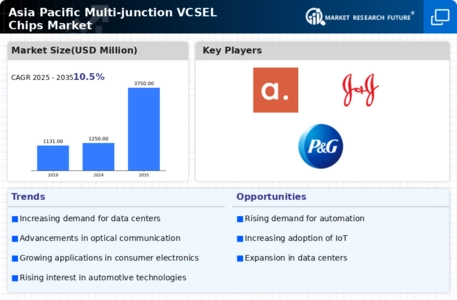Asia Pacific Multi Junction Vcsel Chips Size
Asia Pacific Multi-junction VCSEL Chips Market Growth Projections and Opportunities
The Asia-Pacific Multi-junction VCSEL (Vertical-Cavity Surface-Emitting Laser) Chips Market is experiencing substantial growth, driven by several factors that highlight the increasing importance of advanced laser technology in the region. A primary driver is the growing demand for high-performance optical communication solutions. Multi-junction VCSEL chips are at the forefront of enabling high-speed and energy-efficient data transmission, making them essential components in applications such as data centers, telecommunications, and emerging technologies like 5G networks. As Asia-Pacific nations witness a surge in data consumption and communication infrastructure development, the demand for these advanced VCSEL chips is escalating.
Moreover, the burgeoning consumer electronics market in the Asia-Pacific region is contributing significantly to the growth of the Multi-junction VCSEL Chips Market. These chips are integral to facial recognition systems, depth-sensing cameras, and gesture recognition technologies embedded in smartphones, tablets, and wearable devices. The increasing adoption of these advanced features in consumer electronics, coupled with rising consumer expectations for enhanced functionalities, is driving the demand for high-performance VCSEL chips, positioning them as critical components in next-generation electronic devices. Furthermore, the rapid expansion of the automotive industry in Asia-Pacific is fueling the adoption of Multi-junction VCSEL Chips. These chips find applications in LiDAR (Light Detection and Ranging) systems, which are crucial for autonomous vehicles and advanced driver assistance systems (ADAS).
As countries in the region strive to implement smart transportation solutions, the demand for VCSEL chips in LiDAR applications is witnessing a surge, contributing to the overall growth of the market. The healthcare sector in Asia-Pacific is also a significant contributor to the demand for Multi-junction VCSEL Chips. These chips play a vital role in medical applications such as non-invasive sensing, diagnostics, and imaging. The precision and reliability offered by VCSEL technology make it well-suited for medical devices, creating opportunities for the integration of VCSEL chips in various healthcare applications, from monitoring vital signs to advanced imaging technologies. Government initiatives and policies supporting the adoption of advanced technologies, including VCSEL chips, are playing a crucial role in shaping the market landscape. As countries in Asia-Pacific emphasize technological innovation and invest in research and development, the market for Multi-junction VCSEL Chips is poised for sustained growth.






Leave a Comment